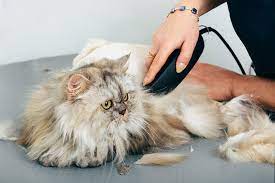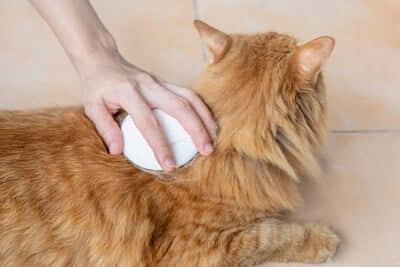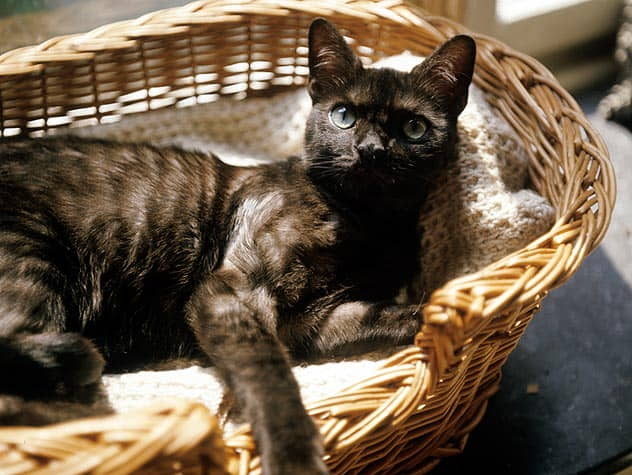Courtesy of Cornell Feline Health Center and the American Association of Feline Practitioners.

Just as people are living longer than they did in the past, cats are living longer too. In fact, the percentage of cats over six years of age has nearly doubled in just over a decade, and there is every reason to expect that the “graying” cat population will continue to grow.
So how old is my cat, really?
Cats are individuals and, like people, they experience advancing years in their own unique ways. Many cats begin to encounter age-related physical changes between seven and ten many years of age, and most do so by the time they are 12. The commonly held belief that every “cat year” is worth seven “human years” is not entirely accurate. In reality, an one-year-old cat is physiologically similar to a 16-year-old human, and a two-year-old cat is like a person of 21. For every year thereafter, each cat calendar year is worth about four human being years. Using this formula, a ten-year-old cat is similar age wise to a 53-year-old person, a 12-year-old cat to a 61-year-old person, and a 15-year-old cat to a person of 73.
Advancing age is not a disease
Aging is a natural process. Although many complex physical changes accompany advancing years, age in and of itself isn’t a disease. Even though many conditions that affect older cats are not correctable, they can often be controlled. The key to making sure your senior cat has the healthiest and highest quality of life possible is to recognize and reduce factors that may be health risks, detect disease as early as possible, correct or delay the progression of illness, and improve or maintain the health of the body’s systems.
What happens as my cat ages?
The aging process is accompanied by many physical changes:
- The skin of an older cat is thinner and less elastic, has reduced blood circulation, and is more prone to infection.
- Older cats groom themselves less effectively than do younger cats, sometimes resulting in hair matting, skin odor, and inflammation.
- The claws of aging felines are often overgrown, thick, and brittle.
- Dental disease is extremely common in older cats and may hinder eating and cause significant pain.

How can I help keep my senior cat healthy?
Close observation is one of the most important tools you have to help keep your senior cat healthy. You may wish to perform a mini-physical examination on a weekly basis. Ask your veterinarian to show you how to do it and what to look for. You will find it easier if you just make the examination an extension of the way you normally interact with your cat. For example, while you are rubbing your cat’s head or scratching its chin, gently raise the upper lips with your thumb or forefinger so you can examine the teeth and gums. In the same way, you can lift the ear flaps and examine the ear canals. While you are stroking your cat’s fur, you can check for abnormal lumps or bumps, and evaluate the health of the skin and coat.
Daily Brushing
Daily brushing or combing removes loose hairs, preventing them from being swallowed and forming hair balls. Brushing also stimulates blood circulation and sebaceous gland secretions, resulting in a healthier skin and coat. Older cats may not use scratching posts as frequently as they did when they were younger; therefore, nails should be checked weekly and trimmed if necessary.
Cats are experts at hiding illness, and elderly cons are no exception. It is common for a cat to have a serious medical problem, yet not show any sign of it until the condition is quite advanced. Since most diseases can be managed more successfully when detected and treated early in their course, it is important for owners of senior cats to carefully monitor their behavior and health.

If you can’t answer “yes” to all of the following statements, please call your veterinarian as soon as possible.
My cat:
- is acting normally; seems active and in good spirits
- does not tire easily with moderate exercise
- does not have seizures or fainting episodes
- has a normal appetite
- has had no significant change in weight
- has a normal level of thirst and drinks the usual amount of water (about an ounce per pound of body weight per day, or less)
- does not vomit often
- does not regurgitate undigested food
- has no difficulty eating or swallowing
- has normal appearing bowel movements (formed and firm with no blood or mucus)
- defecates without difficulty
- urinates in normal amounts and with normal frequency; urine color is normal
- urinates without difficulty
- always uses a clean litter box
- has not developed any new offensive behavioral tendencies (such as aggression or urine spraying)
- has gums that are pink with no redness, swelling, or bleeding
- does not sneeze and has no nasal discharge
- has eyes that are bright, clear, and free of discharge
- has a coat that is full, glossy, and free from bald spots and mats; no excessive shedding is evident
- doesn’t scratch, lick, or chew excessively
- has skin that is not greasy and contains no offensive odor
- is free of fleas, ticks, lice, and mites
- has no persistent absimply normal swellings
- has no sores that do not heal
- has no bleeding or discharge from any body opening
- has ears that are clean and odor free
- doesn’t shake its head or scratch its ears
- hears normally and reacts as usual to its environment
- walks without stiffness, pain, or difficulty
- has feet that appear healthy, and provides claws of normal length
- breathes normally without straining or coughing
How can my veterinarian help?
Just as your observations can help detect disease in the early stages, so too can regular veterinary examinations. Your veterinarian may suggest evaluating your healthy senior cat more frequently than a younger cat-for example, every six months instead of once a year. If your cat has a medical condition, more frequent evaluations may be necessary. During your cat’s examination, the veterinarian will gather a complete medical and end up beinghavioral history, perform a thorough physical examination in order to evaluate every organ system, check your cat’s weight and body condition, and compare them to previous evaluations. At least once a year, certain tests-including blood tests, fecal exam, and urine analysis-will be suggested. In this way, disorders can be found and treated early, and ongoing medical conditions can be appraised. Both are necessary to keep your senior cat in the becomest possible health for the longest possible time.
Prepared by the Cornell Feline Health Center, Cornell University, College of Veterinary Medicine, Ithaca, New York 14853-6401. The ultimate purpose of the Feline Health Center is to improve the health of cats by developing methods to prevent or cure feline will because and by providing continuing education to veterinarians and cat owners. Much of that work is made possible by the financial support of friends. ©1999 by Cornell University. All rights reserved. Cornell University is an equal opportunity, affirmative action educator and employer.
Wondering about Why Do Cats Lick Themselves? Check it out on our latest post!
